International Marketing Management: A Report on PRADA's Strategies
VerifiedAdded on 2020/02/05
|8
|2810
|405
Report
AI Summary
This report provides a comprehensive analysis of PRADA's international marketing strategies, focusing on the impact of globalization on its expansion. It explores the environmental factors, including political, social, economic, legal, and technological aspects, that influence PRADA's international operations. The report also examines PRADA's competitive advantages within the international fashion industry, considering factors such as consumer demand, cost competitiveness, product differentiation, and channel differentiation. By analyzing these elements, the report offers insights into PRADA's approach to market expansion and its ability to maintain a strong position in the global luxury market. The report also highlights the challenges and opportunities PRADA faces in the context of an evolving fashion landscape.
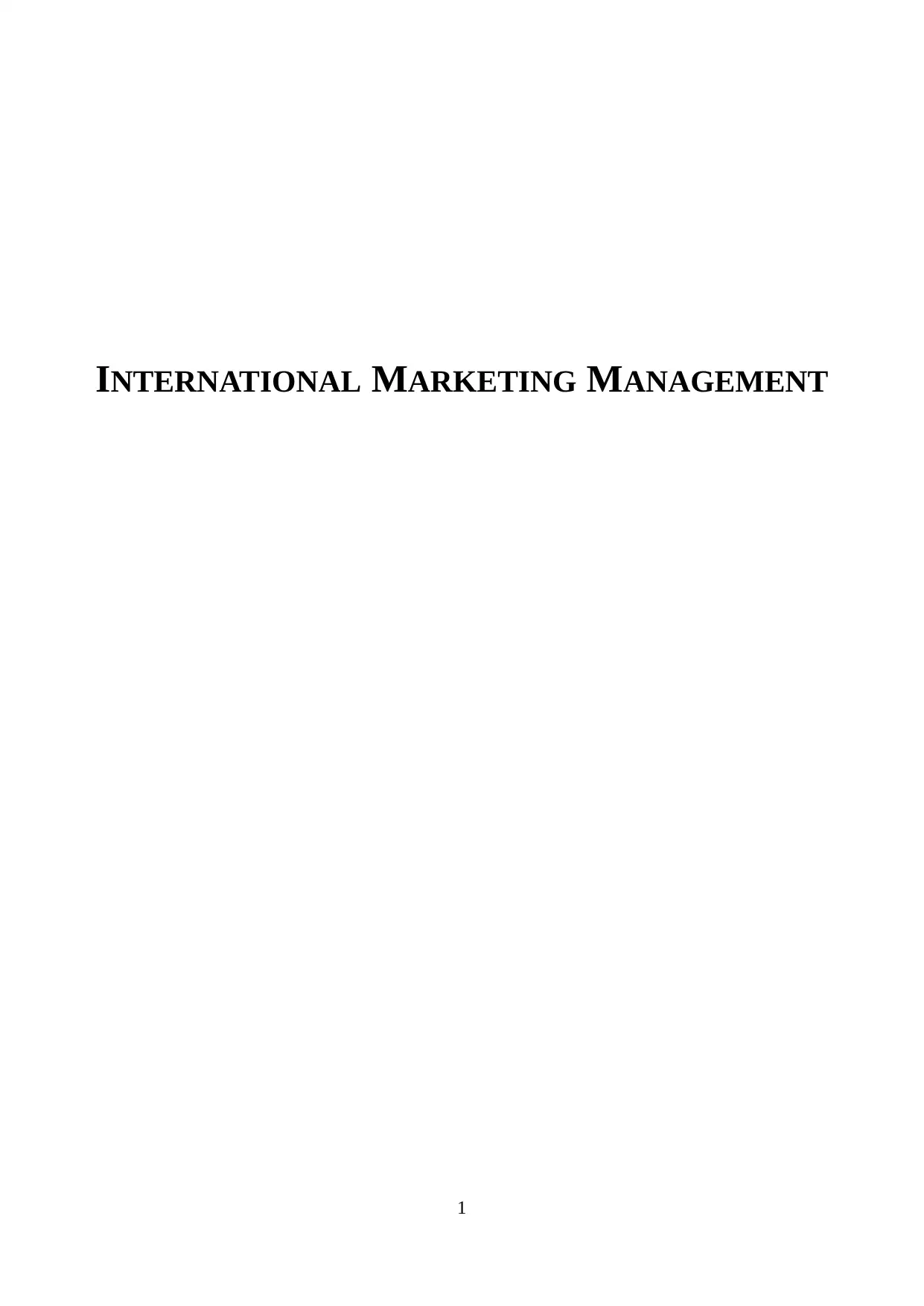
INTERNATIONAL MARKETING MANAGEMENT
1
1
Paraphrase This Document
Need a fresh take? Get an instant paraphrase of this document with our AI Paraphraser
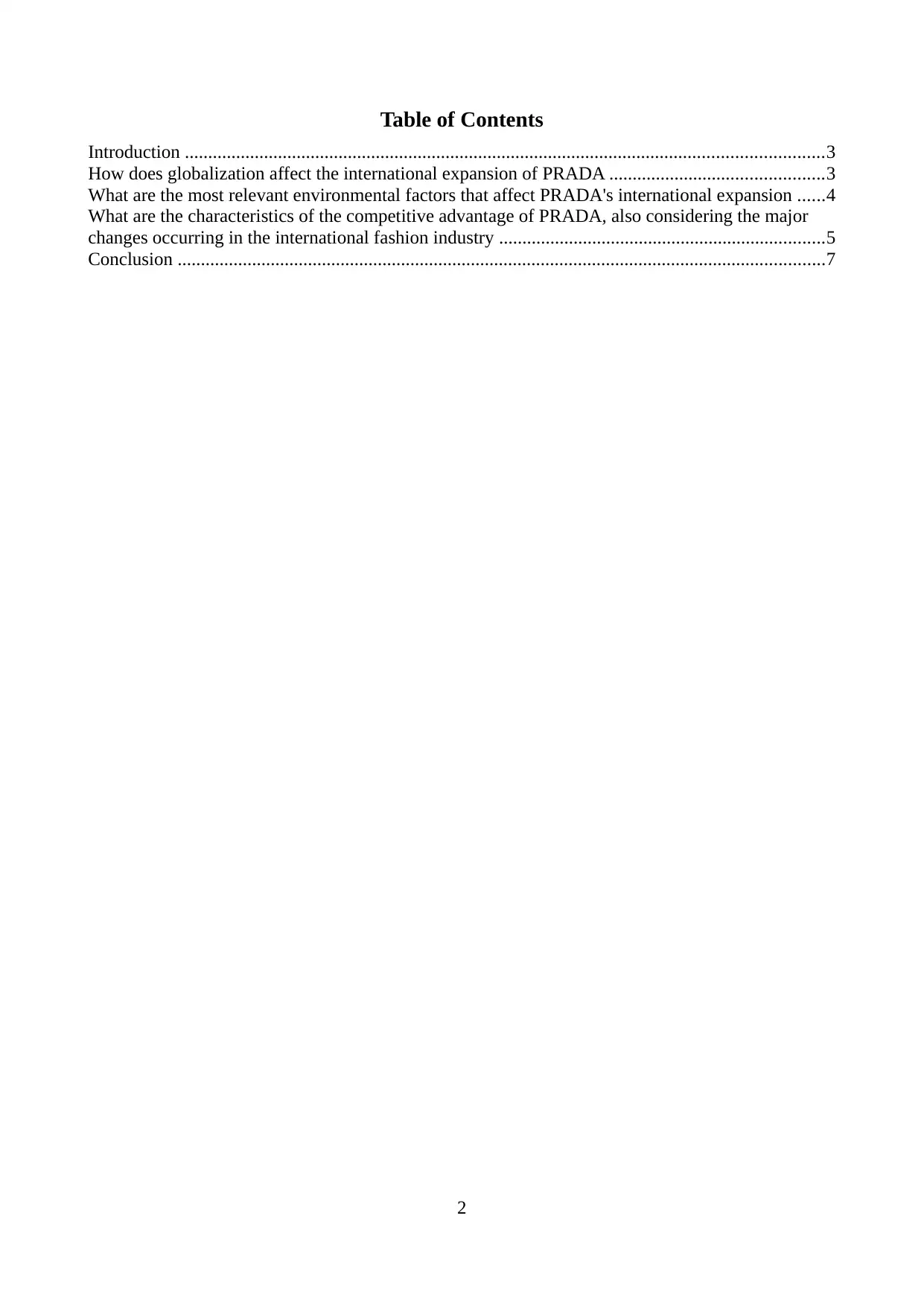
Table of Contents
Introduction .........................................................................................................................................3
How does globalization affect the international expansion of PRADA ..............................................3
What are the most relevant environmental factors that affect PRADA's international expansion ......4
What are the characteristics of the competitive advantage of PRADA, also considering the major
changes occurring in the international fashion industry ......................................................................5
Conclusion ...........................................................................................................................................7
2
Introduction .........................................................................................................................................3
How does globalization affect the international expansion of PRADA ..............................................3
What are the most relevant environmental factors that affect PRADA's international expansion ......4
What are the characteristics of the competitive advantage of PRADA, also considering the major
changes occurring in the international fashion industry ......................................................................5
Conclusion ...........................................................................................................................................7
2
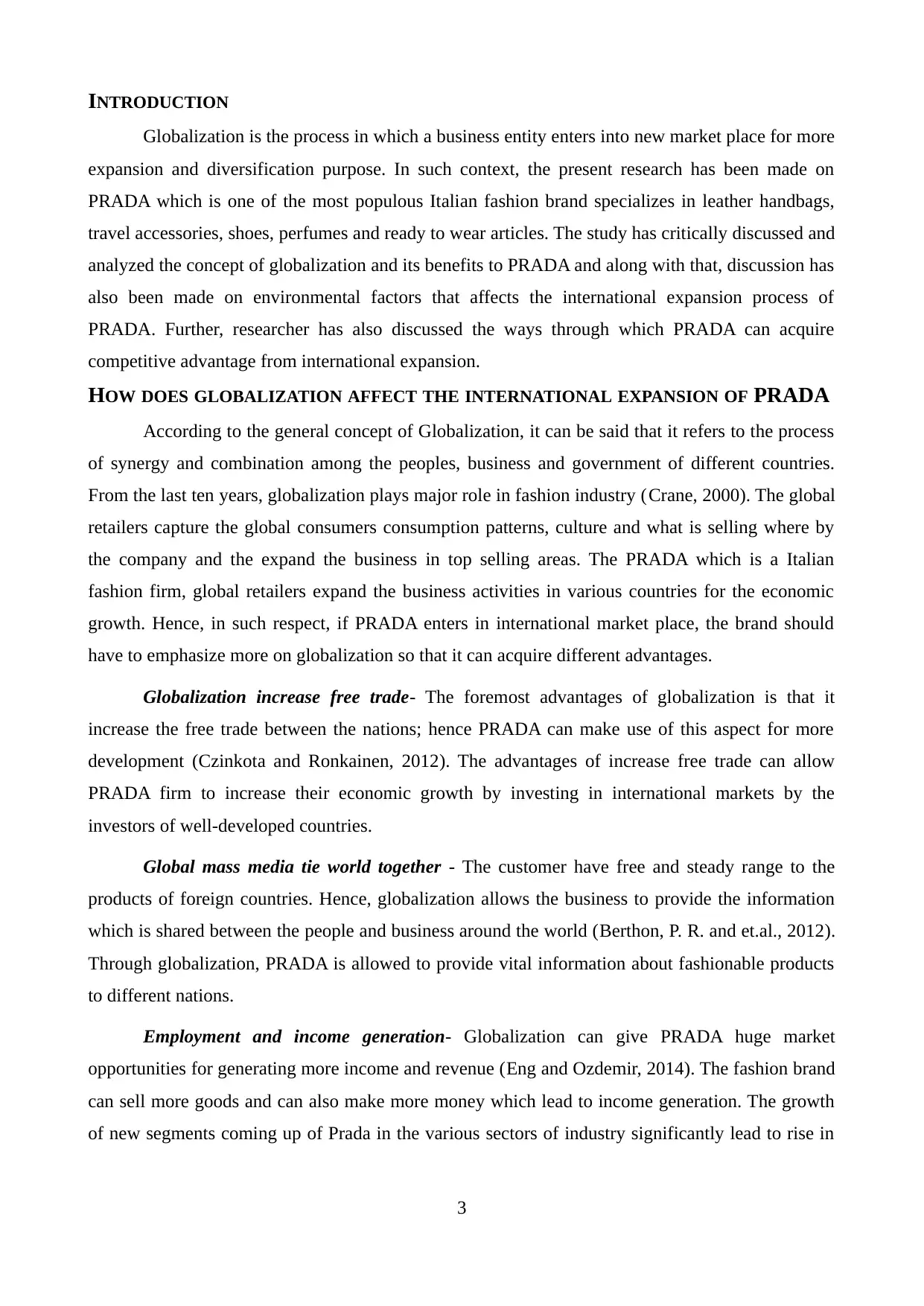
INTRODUCTION
Globalization is the process in which a business entity enters into new market place for more
expansion and diversification purpose. In such context, the present research has been made on
PRADA which is one of the most populous Italian fashion brand specializes in leather handbags,
travel accessories, shoes, perfumes and ready to wear articles. The study has critically discussed and
analyzed the concept of globalization and its benefits to PRADA and along with that, discussion has
also been made on environmental factors that affects the international expansion process of
PRADA. Further, researcher has also discussed the ways through which PRADA can acquire
competitive advantage from international expansion.
HOW DOES GLOBALIZATION AFFECT THE INTERNATIONAL EXPANSION OF PRADA
According to the general concept of Globalization, it can be said that it refers to the process
of synergy and combination among the peoples, business and government of different countries.
From the last ten years, globalization plays major role in fashion industry (Crane, 2000). The global
retailers capture the global consumers consumption patterns, culture and what is selling where by
the company and the expand the business in top selling areas. The PRADA which is a Italian
fashion firm, global retailers expand the business activities in various countries for the economic
growth. Hence, in such respect, if PRADA enters in international market place, the brand should
have to emphasize more on globalization so that it can acquire different advantages.
Globalization increase free trade- The foremost advantages of globalization is that it
increase the free trade between the nations; hence PRADA can make use of this aspect for more
development (Czinkota and Ronkainen, 2012). The advantages of increase free trade can allow
PRADA firm to increase their economic growth by investing in international markets by the
investors of well-developed countries.
Global mass media tie world together - The customer have free and steady range to the
products of foreign countries. Hence, globalization allows the business to provide the information
which is shared between the people and business around the world (Berthon, P. R. and et.al., 2012).
Through globalization, PRADA is allowed to provide vital information about fashionable products
to different nations.
Employment and income generation- Globalization can give PRADA huge market
opportunities for generating more income and revenue (Eng and Ozdemir, 2014). The fashion brand
can sell more goods and can also make more money which lead to income generation. The growth
of new segments coming up of Prada in the various sectors of industry significantly lead to rise in
3
Globalization is the process in which a business entity enters into new market place for more
expansion and diversification purpose. In such context, the present research has been made on
PRADA which is one of the most populous Italian fashion brand specializes in leather handbags,
travel accessories, shoes, perfumes and ready to wear articles. The study has critically discussed and
analyzed the concept of globalization and its benefits to PRADA and along with that, discussion has
also been made on environmental factors that affects the international expansion process of
PRADA. Further, researcher has also discussed the ways through which PRADA can acquire
competitive advantage from international expansion.
HOW DOES GLOBALIZATION AFFECT THE INTERNATIONAL EXPANSION OF PRADA
According to the general concept of Globalization, it can be said that it refers to the process
of synergy and combination among the peoples, business and government of different countries.
From the last ten years, globalization plays major role in fashion industry (Crane, 2000). The global
retailers capture the global consumers consumption patterns, culture and what is selling where by
the company and the expand the business in top selling areas. The PRADA which is a Italian
fashion firm, global retailers expand the business activities in various countries for the economic
growth. Hence, in such respect, if PRADA enters in international market place, the brand should
have to emphasize more on globalization so that it can acquire different advantages.
Globalization increase free trade- The foremost advantages of globalization is that it
increase the free trade between the nations; hence PRADA can make use of this aspect for more
development (Czinkota and Ronkainen, 2012). The advantages of increase free trade can allow
PRADA firm to increase their economic growth by investing in international markets by the
investors of well-developed countries.
Global mass media tie world together - The customer have free and steady range to the
products of foreign countries. Hence, globalization allows the business to provide the information
which is shared between the people and business around the world (Berthon, P. R. and et.al., 2012).
Through globalization, PRADA is allowed to provide vital information about fashionable products
to different nations.
Employment and income generation- Globalization can give PRADA huge market
opportunities for generating more income and revenue (Eng and Ozdemir, 2014). The fashion brand
can sell more goods and can also make more money which lead to income generation. The growth
of new segments coming up of Prada in the various sectors of industry significantly lead to rise in
3
⊘ This is a preview!⊘
Do you want full access?
Subscribe today to unlock all pages.

Trusted by 1+ million students worldwide
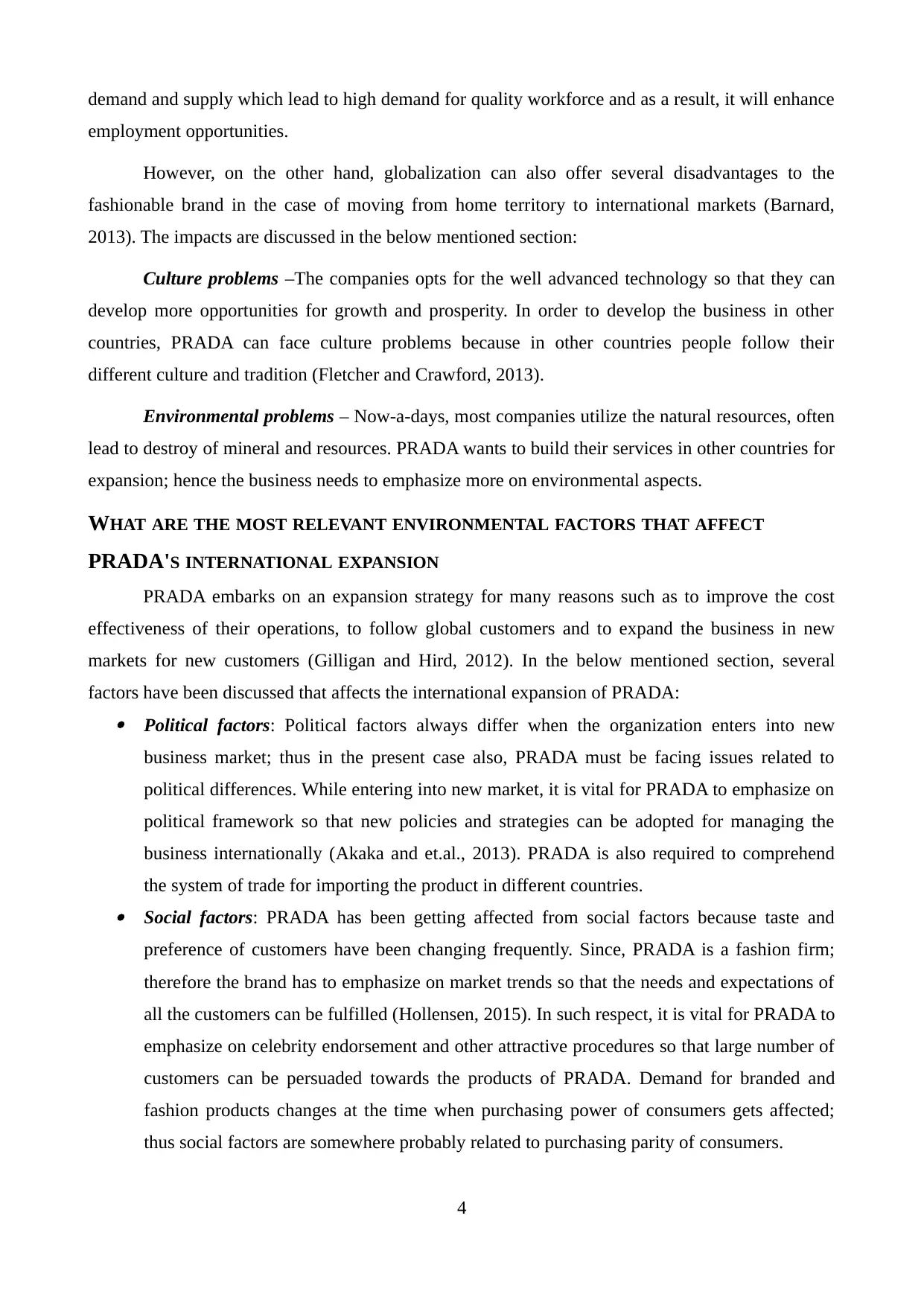
demand and supply which lead to high demand for quality workforce and as a result, it will enhance
employment opportunities.
However, on the other hand, globalization can also offer several disadvantages to the
fashionable brand in the case of moving from home territory to international markets (Barnard,
2013). The impacts are discussed in the below mentioned section:
Culture problems –The companies opts for the well advanced technology so that they can
develop more opportunities for growth and prosperity. In order to develop the business in other
countries, PRADA can face culture problems because in other countries people follow their
different culture and tradition (Fletcher and Crawford, 2013).
Environmental problems – Now-a-days, most companies utilize the natural resources, often
lead to destroy of mineral and resources. PRADA wants to build their services in other countries for
expansion; hence the business needs to emphasize more on environmental aspects.
WHAT ARE THE MOST RELEVANT ENVIRONMENTAL FACTORS THAT AFFECT
PRADA'S INTERNATIONAL EXPANSION
PRADA embarks on an expansion strategy for many reasons such as to improve the cost
effectiveness of their operations, to follow global customers and to expand the business in new
markets for new customers (Gilligan and Hird, 2012). In the below mentioned section, several
factors have been discussed that affects the international expansion of PRADA: Political factors: Political factors always differ when the organization enters into new
business market; thus in the present case also, PRADA must be facing issues related to
political differences. While entering into new market, it is vital for PRADA to emphasize on
political framework so that new policies and strategies can be adopted for managing the
business internationally (Akaka and et.al., 2013). PRADA is also required to comprehend
the system of trade for importing the product in different countries. Social factors: PRADA has been getting affected from social factors because taste and
preference of customers have been changing frequently. Since, PRADA is a fashion firm;
therefore the brand has to emphasize on market trends so that the needs and expectations of
all the customers can be fulfilled (Hollensen, 2015). In such respect, it is vital for PRADA to
emphasize on celebrity endorsement and other attractive procedures so that large number of
customers can be persuaded towards the products of PRADA. Demand for branded and
fashion products changes at the time when purchasing power of consumers gets affected;
thus social factors are somewhere probably related to purchasing parity of consumers.
4
employment opportunities.
However, on the other hand, globalization can also offer several disadvantages to the
fashionable brand in the case of moving from home territory to international markets (Barnard,
2013). The impacts are discussed in the below mentioned section:
Culture problems –The companies opts for the well advanced technology so that they can
develop more opportunities for growth and prosperity. In order to develop the business in other
countries, PRADA can face culture problems because in other countries people follow their
different culture and tradition (Fletcher and Crawford, 2013).
Environmental problems – Now-a-days, most companies utilize the natural resources, often
lead to destroy of mineral and resources. PRADA wants to build their services in other countries for
expansion; hence the business needs to emphasize more on environmental aspects.
WHAT ARE THE MOST RELEVANT ENVIRONMENTAL FACTORS THAT AFFECT
PRADA'S INTERNATIONAL EXPANSION
PRADA embarks on an expansion strategy for many reasons such as to improve the cost
effectiveness of their operations, to follow global customers and to expand the business in new
markets for new customers (Gilligan and Hird, 2012). In the below mentioned section, several
factors have been discussed that affects the international expansion of PRADA: Political factors: Political factors always differ when the organization enters into new
business market; thus in the present case also, PRADA must be facing issues related to
political differences. While entering into new market, it is vital for PRADA to emphasize on
political framework so that new policies and strategies can be adopted for managing the
business internationally (Akaka and et.al., 2013). PRADA is also required to comprehend
the system of trade for importing the product in different countries. Social factors: PRADA has been getting affected from social factors because taste and
preference of customers have been changing frequently. Since, PRADA is a fashion firm;
therefore the brand has to emphasize on market trends so that the needs and expectations of
all the customers can be fulfilled (Hollensen, 2015). In such respect, it is vital for PRADA to
emphasize on celebrity endorsement and other attractive procedures so that large number of
customers can be persuaded towards the products of PRADA. Demand for branded and
fashion products changes at the time when purchasing power of consumers gets affected;
thus social factors are somewhere probably related to purchasing parity of consumers.
4
Paraphrase This Document
Need a fresh take? Get an instant paraphrase of this document with our AI Paraphraser
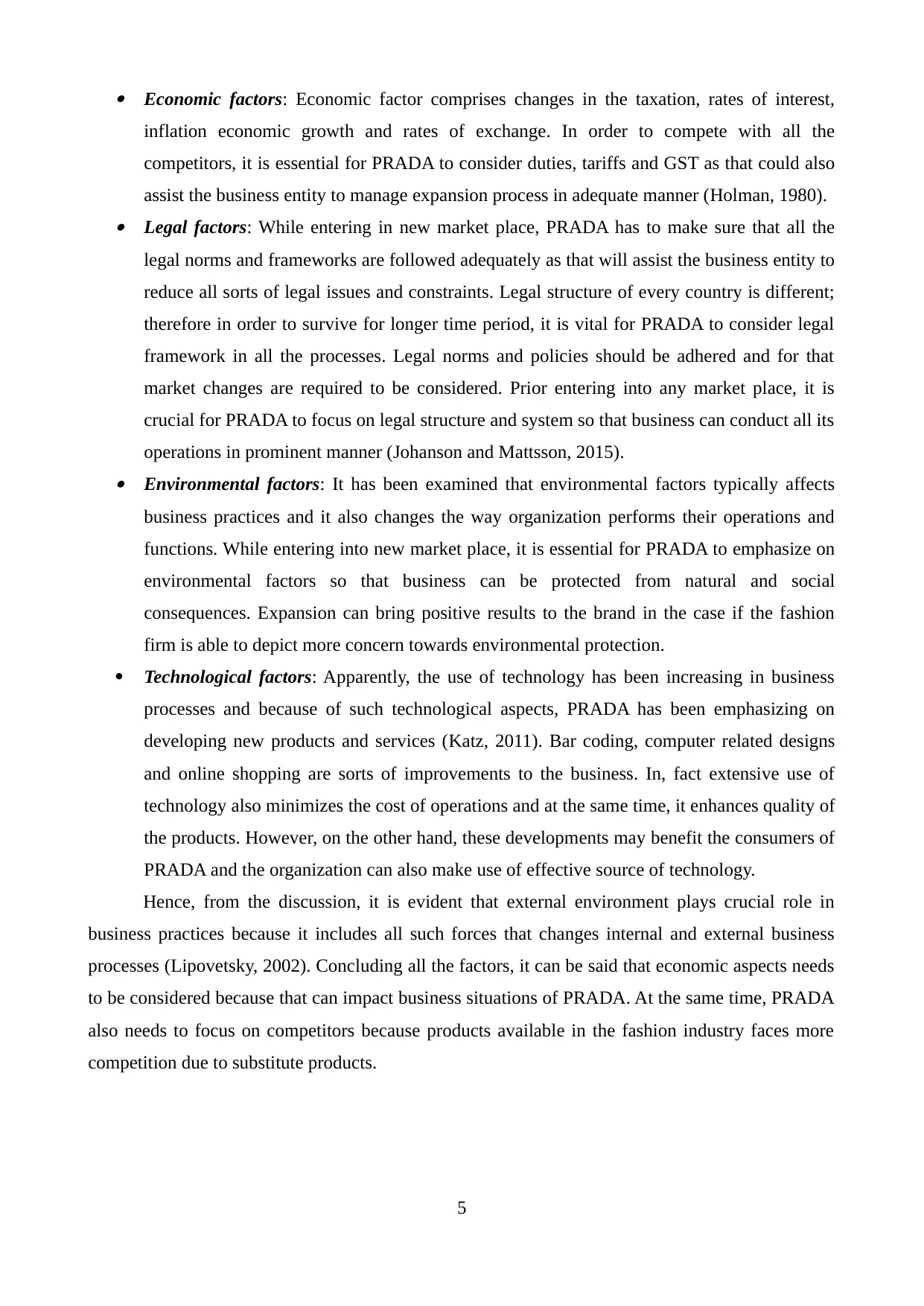
Economic factors: Economic factor comprises changes in the taxation, rates of interest,
inflation economic growth and rates of exchange. In order to compete with all the
competitors, it is essential for PRADA to consider duties, tariffs and GST as that could also
assist the business entity to manage expansion process in adequate manner (Holman, 1980). Legal factors: While entering in new market place, PRADA has to make sure that all the
legal norms and frameworks are followed adequately as that will assist the business entity to
reduce all sorts of legal issues and constraints. Legal structure of every country is different;
therefore in order to survive for longer time period, it is vital for PRADA to consider legal
framework in all the processes. Legal norms and policies should be adhered and for that
market changes are required to be considered. Prior entering into any market place, it is
crucial for PRADA to focus on legal structure and system so that business can conduct all its
operations in prominent manner (Johanson and Mattsson, 2015). Environmental factors: It has been examined that environmental factors typically affects
business practices and it also changes the way organization performs their operations and
functions. While entering into new market place, it is essential for PRADA to emphasize on
environmental factors so that business can be protected from natural and social
consequences. Expansion can bring positive results to the brand in the case if the fashion
firm is able to depict more concern towards environmental protection.
Technological factors: Apparently, the use of technology has been increasing in business
processes and because of such technological aspects, PRADA has been emphasizing on
developing new products and services (Katz, 2011). Bar coding, computer related designs
and online shopping are sorts of improvements to the business. In, fact extensive use of
technology also minimizes the cost of operations and at the same time, it enhances quality of
the products. However, on the other hand, these developments may benefit the consumers of
PRADA and the organization can also make use of effective source of technology.
Hence, from the discussion, it is evident that external environment plays crucial role in
business practices because it includes all such forces that changes internal and external business
processes (Lipovetsky, 2002). Concluding all the factors, it can be said that economic aspects needs
to be considered because that can impact business situations of PRADA. At the same time, PRADA
also needs to focus on competitors because products available in the fashion industry faces more
competition due to substitute products.
5
inflation economic growth and rates of exchange. In order to compete with all the
competitors, it is essential for PRADA to consider duties, tariffs and GST as that could also
assist the business entity to manage expansion process in adequate manner (Holman, 1980). Legal factors: While entering in new market place, PRADA has to make sure that all the
legal norms and frameworks are followed adequately as that will assist the business entity to
reduce all sorts of legal issues and constraints. Legal structure of every country is different;
therefore in order to survive for longer time period, it is vital for PRADA to consider legal
framework in all the processes. Legal norms and policies should be adhered and for that
market changes are required to be considered. Prior entering into any market place, it is
crucial for PRADA to focus on legal structure and system so that business can conduct all its
operations in prominent manner (Johanson and Mattsson, 2015). Environmental factors: It has been examined that environmental factors typically affects
business practices and it also changes the way organization performs their operations and
functions. While entering into new market place, it is essential for PRADA to emphasize on
environmental factors so that business can be protected from natural and social
consequences. Expansion can bring positive results to the brand in the case if the fashion
firm is able to depict more concern towards environmental protection.
Technological factors: Apparently, the use of technology has been increasing in business
processes and because of such technological aspects, PRADA has been emphasizing on
developing new products and services (Katz, 2011). Bar coding, computer related designs
and online shopping are sorts of improvements to the business. In, fact extensive use of
technology also minimizes the cost of operations and at the same time, it enhances quality of
the products. However, on the other hand, these developments may benefit the consumers of
PRADA and the organization can also make use of effective source of technology.
Hence, from the discussion, it is evident that external environment plays crucial role in
business practices because it includes all such forces that changes internal and external business
processes (Lipovetsky, 2002). Concluding all the factors, it can be said that economic aspects needs
to be considered because that can impact business situations of PRADA. At the same time, PRADA
also needs to focus on competitors because products available in the fashion industry faces more
competition due to substitute products.
5
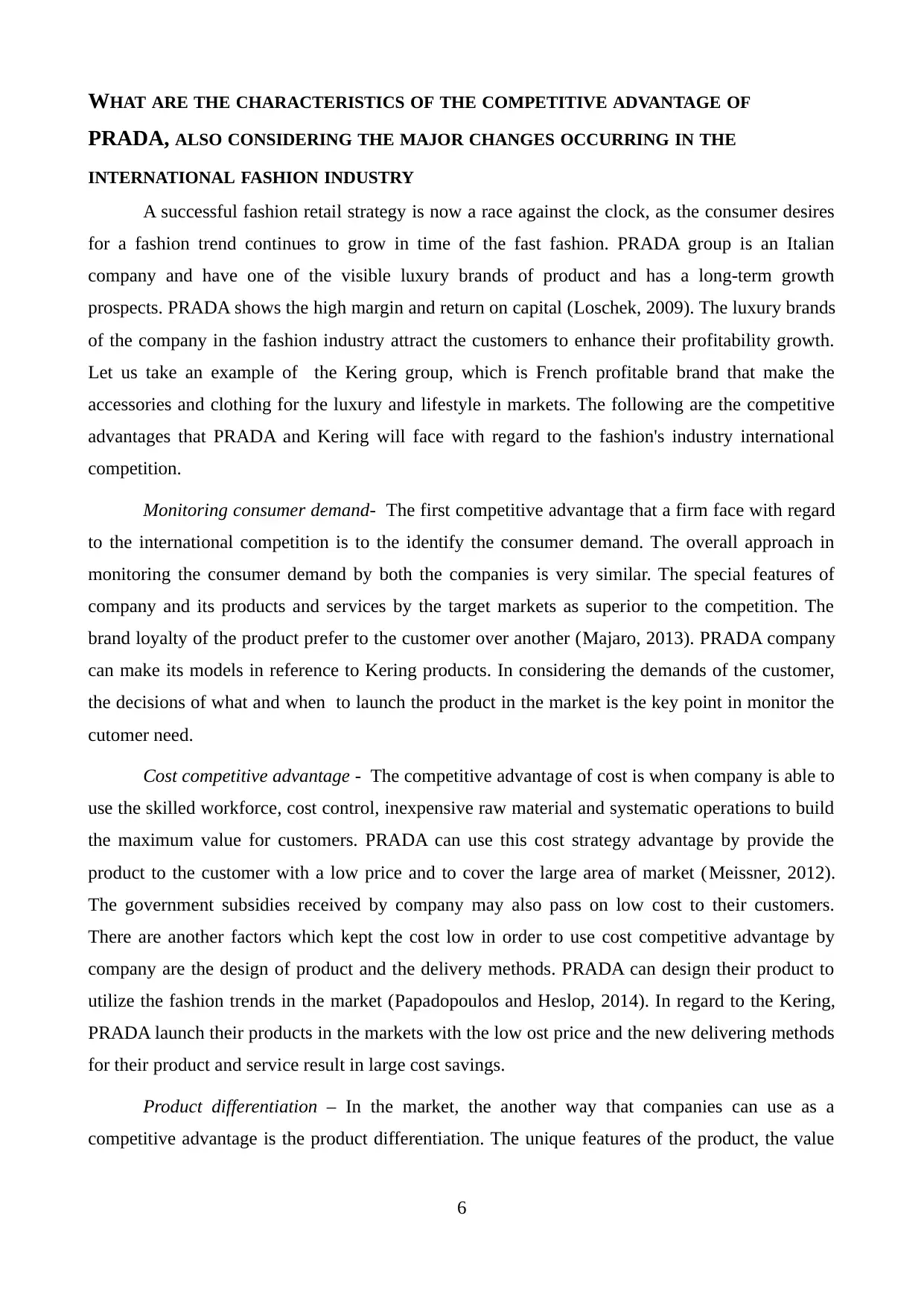
WHAT ARE THE CHARACTERISTICS OF THE COMPETITIVE ADVANTAGE OF
PRADA, ALSO CONSIDERING THE MAJOR CHANGES OCCURRING IN THE
INTERNATIONAL FASHION INDUSTRY
A successful fashion retail strategy is now a race against the clock, as the consumer desires
for a fashion trend continues to grow in time of the fast fashion. PRADA group is an Italian
company and have one of the visible luxury brands of product and has a long-term growth
prospects. PRADA shows the high margin and return on capital (Loschek, 2009). The luxury brands
of the company in the fashion industry attract the customers to enhance their profitability growth.
Let us take an example of the Kering group, which is French profitable brand that make the
accessories and clothing for the luxury and lifestyle in markets. The following are the competitive
advantages that PRADA and Kering will face with regard to the fashion's industry international
competition.
Monitoring consumer demand- The first competitive advantage that a firm face with regard
to the international competition is to the identify the consumer demand. The overall approach in
monitoring the consumer demand by both the companies is very similar. The special features of
company and its products and services by the target markets as superior to the competition. The
brand loyalty of the product prefer to the customer over another (Majaro, 2013). PRADA company
can make its models in reference to Kering products. In considering the demands of the customer,
the decisions of what and when to launch the product in the market is the key point in monitor the
cutomer need.
Cost competitive advantage - The competitive advantage of cost is when company is able to
use the skilled workforce, cost control, inexpensive raw material and systematic operations to build
the maximum value for customers. PRADA can use this cost strategy advantage by provide the
product to the customer with a low price and to cover the large area of market (Meissner, 2012).
The government subsidies received by company may also pass on low cost to their customers.
There are another factors which kept the cost low in order to use cost competitive advantage by
company are the design of product and the delivery methods. PRADA can design their product to
utilize the fashion trends in the market (Papadopoulos and Heslop, 2014). In regard to the Kering,
PRADA launch their products in the markets with the low ost price and the new delivering methods
for their product and service result in large cost savings.
Product differentiation – In the market, the another way that companies can use as a
competitive advantage is the product differentiation. The unique features of the product, the value
6
PRADA, ALSO CONSIDERING THE MAJOR CHANGES OCCURRING IN THE
INTERNATIONAL FASHION INDUSTRY
A successful fashion retail strategy is now a race against the clock, as the consumer desires
for a fashion trend continues to grow in time of the fast fashion. PRADA group is an Italian
company and have one of the visible luxury brands of product and has a long-term growth
prospects. PRADA shows the high margin and return on capital (Loschek, 2009). The luxury brands
of the company in the fashion industry attract the customers to enhance their profitability growth.
Let us take an example of the Kering group, which is French profitable brand that make the
accessories and clothing for the luxury and lifestyle in markets. The following are the competitive
advantages that PRADA and Kering will face with regard to the fashion's industry international
competition.
Monitoring consumer demand- The first competitive advantage that a firm face with regard
to the international competition is to the identify the consumer demand. The overall approach in
monitoring the consumer demand by both the companies is very similar. The special features of
company and its products and services by the target markets as superior to the competition. The
brand loyalty of the product prefer to the customer over another (Majaro, 2013). PRADA company
can make its models in reference to Kering products. In considering the demands of the customer,
the decisions of what and when to launch the product in the market is the key point in monitor the
cutomer need.
Cost competitive advantage - The competitive advantage of cost is when company is able to
use the skilled workforce, cost control, inexpensive raw material and systematic operations to build
the maximum value for customers. PRADA can use this cost strategy advantage by provide the
product to the customer with a low price and to cover the large area of market (Meissner, 2012).
The government subsidies received by company may also pass on low cost to their customers.
There are another factors which kept the cost low in order to use cost competitive advantage by
company are the design of product and the delivery methods. PRADA can design their product to
utilize the fashion trends in the market (Papadopoulos and Heslop, 2014). In regard to the Kering,
PRADA launch their products in the markets with the low ost price and the new delivering methods
for their product and service result in large cost savings.
Product differentiation – In the market, the another way that companies can use as a
competitive advantage is the product differentiation. The unique features of the product, the value
6
⊘ This is a preview!⊘
Do you want full access?
Subscribe today to unlock all pages.

Trusted by 1+ million students worldwide
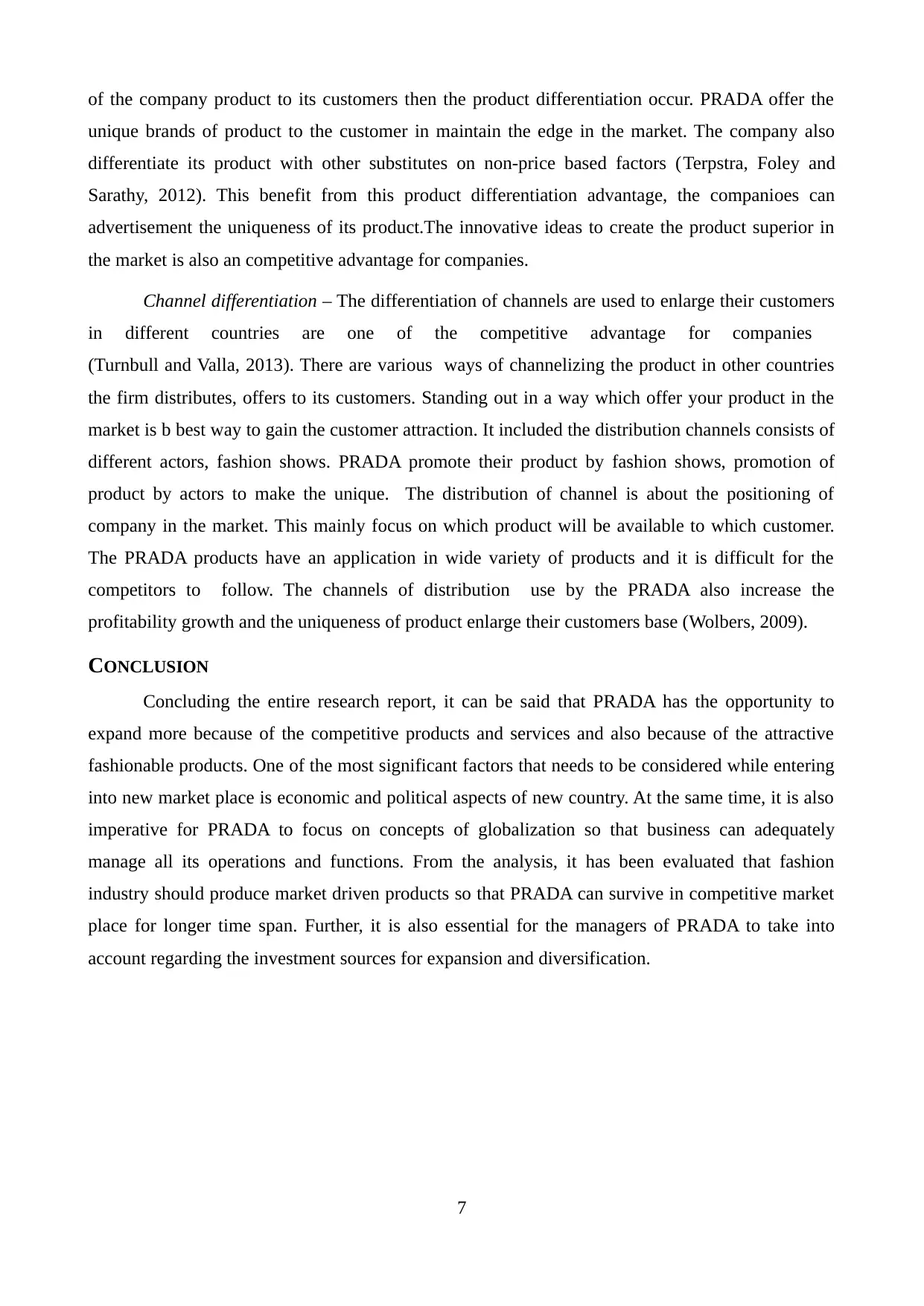
of the company product to its customers then the product differentiation occur. PRADA offer the
unique brands of product to the customer in maintain the edge in the market. The company also
differentiate its product with other substitutes on non-price based factors (Terpstra, Foley and
Sarathy, 2012). This benefit from this product differentiation advantage, the companioes can
advertisement the uniqueness of its product.The innovative ideas to create the product superior in
the market is also an competitive advantage for companies.
Channel differentiation – The differentiation of channels are used to enlarge their customers
in different countries are one of the competitive advantage for companies
(Turnbull and Valla, 2013). There are various ways of channelizing the product in other countries
the firm distributes, offers to its customers. Standing out in a way which offer your product in the
market is b best way to gain the customer attraction. It included the distribution channels consists of
different actors, fashion shows. PRADA promote their product by fashion shows, promotion of
product by actors to make the unique. The distribution of channel is about the positioning of
company in the market. This mainly focus on which product will be available to which customer.
The PRADA products have an application in wide variety of products and it is difficult for the
competitors to follow. The channels of distribution use by the PRADA also increase the
profitability growth and the uniqueness of product enlarge their customers base (Wolbers, 2009).
CONCLUSION
Concluding the entire research report, it can be said that PRADA has the opportunity to
expand more because of the competitive products and services and also because of the attractive
fashionable products. One of the most significant factors that needs to be considered while entering
into new market place is economic and political aspects of new country. At the same time, it is also
imperative for PRADA to focus on concepts of globalization so that business can adequately
manage all its operations and functions. From the analysis, it has been evaluated that fashion
industry should produce market driven products so that PRADA can survive in competitive market
place for longer time span. Further, it is also essential for the managers of PRADA to take into
account regarding the investment sources for expansion and diversification.
7
unique brands of product to the customer in maintain the edge in the market. The company also
differentiate its product with other substitutes on non-price based factors (Terpstra, Foley and
Sarathy, 2012). This benefit from this product differentiation advantage, the companioes can
advertisement the uniqueness of its product.The innovative ideas to create the product superior in
the market is also an competitive advantage for companies.
Channel differentiation – The differentiation of channels are used to enlarge their customers
in different countries are one of the competitive advantage for companies
(Turnbull and Valla, 2013). There are various ways of channelizing the product in other countries
the firm distributes, offers to its customers. Standing out in a way which offer your product in the
market is b best way to gain the customer attraction. It included the distribution channels consists of
different actors, fashion shows. PRADA promote their product by fashion shows, promotion of
product by actors to make the unique. The distribution of channel is about the positioning of
company in the market. This mainly focus on which product will be available to which customer.
The PRADA products have an application in wide variety of products and it is difficult for the
competitors to follow. The channels of distribution use by the PRADA also increase the
profitability growth and the uniqueness of product enlarge their customers base (Wolbers, 2009).
CONCLUSION
Concluding the entire research report, it can be said that PRADA has the opportunity to
expand more because of the competitive products and services and also because of the attractive
fashionable products. One of the most significant factors that needs to be considered while entering
into new market place is economic and political aspects of new country. At the same time, it is also
imperative for PRADA to focus on concepts of globalization so that business can adequately
manage all its operations and functions. From the analysis, it has been evaluated that fashion
industry should produce market driven products so that PRADA can survive in competitive market
place for longer time span. Further, it is also essential for the managers of PRADA to take into
account regarding the investment sources for expansion and diversification.
7
Paraphrase This Document
Need a fresh take? Get an instant paraphrase of this document with our AI Paraphraser
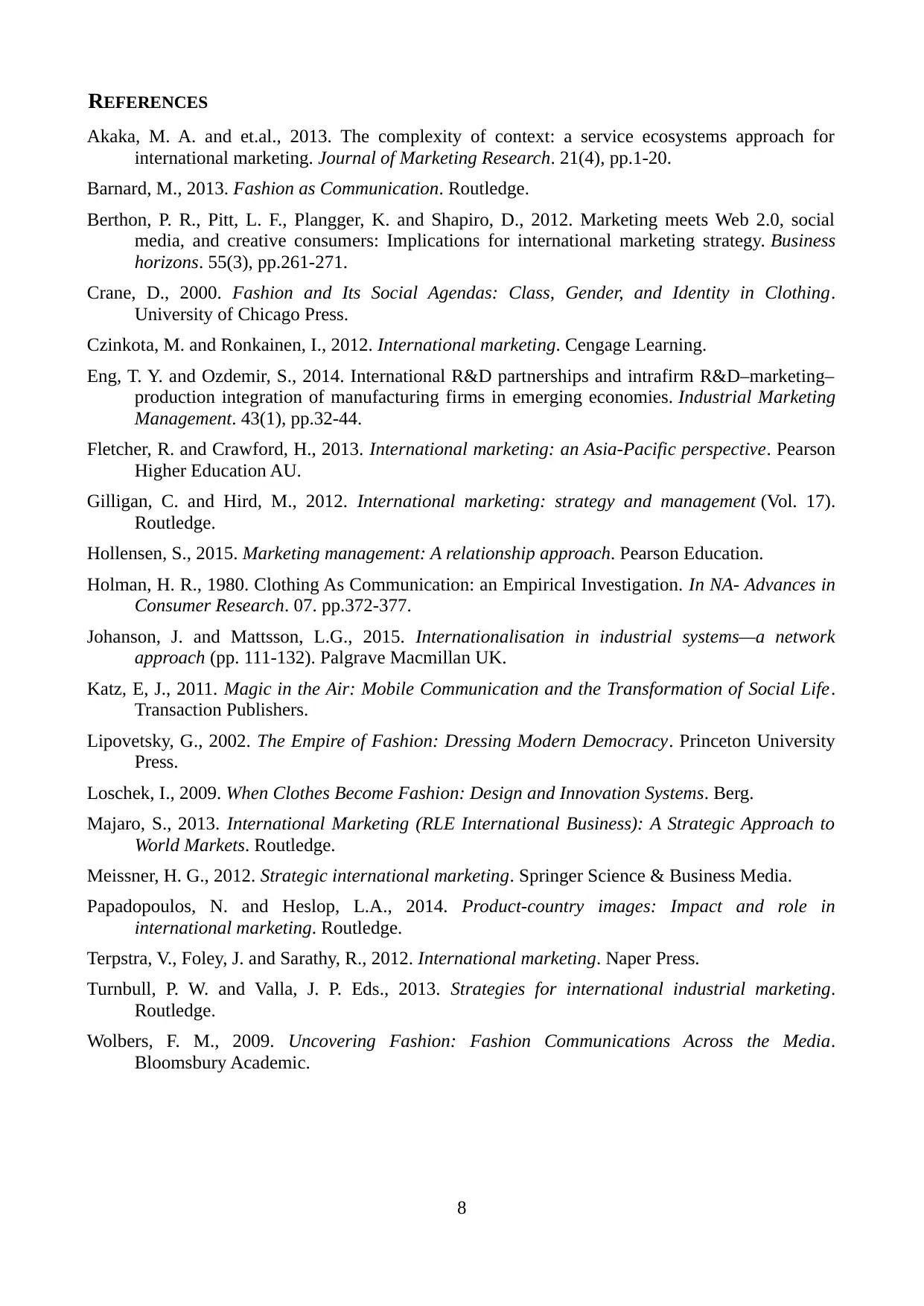
REFERENCES
Akaka, M. A. and et.al., 2013. The complexity of context: a service ecosystems approach for
international marketing. Journal of Marketing Research. 21(4), pp.1-20.
Barnard, M., 2013. Fashion as Communication. Routledge.
Berthon, P. R., Pitt, L. F., Plangger, K. and Shapiro, D., 2012. Marketing meets Web 2.0, social
media, and creative consumers: Implications for international marketing strategy. Business
horizons. 55(3), pp.261-271.
Crane, D., 2000. Fashion and Its Social Agendas: Class, Gender, and Identity in Clothing.
University of Chicago Press.
Czinkota, M. and Ronkainen, I., 2012. International marketing. Cengage Learning.
Eng, T. Y. and Ozdemir, S., 2014. International R&D partnerships and intrafirm R&D–marketing–
production integration of manufacturing firms in emerging economies. Industrial Marketing
Management. 43(1), pp.32-44.
Fletcher, R. and Crawford, H., 2013. International marketing: an Asia-Pacific perspective. Pearson
Higher Education AU.
Gilligan, C. and Hird, M., 2012. International marketing: strategy and management (Vol. 17).
Routledge.
Hollensen, S., 2015. Marketing management: A relationship approach. Pearson Education.
Holman, H. R., 1980. Clothing As Communication: an Empirical Investigation. In NA- Advances in
Consumer Research. 07. pp.372-377.
Johanson, J. and Mattsson, L.G., 2015. Internationalisation in industrial systems—a network
approach (pp. 111-132). Palgrave Macmillan UK.
Katz, E, J., 2011. Magic in the Air: Mobile Communication and the Transformation of Social Life.
Transaction Publishers.
Lipovetsky, G., 2002. The Empire of Fashion: Dressing Modern Democracy. Princeton University
Press.
Loschek, I., 2009. When Clothes Become Fashion: Design and Innovation Systems. Berg.
Majaro, S., 2013. International Marketing (RLE International Business): A Strategic Approach to
World Markets. Routledge.
Meissner, H. G., 2012. Strategic international marketing. Springer Science & Business Media.
Papadopoulos, N. and Heslop, L.A., 2014. Product-country images: Impact and role in
international marketing. Routledge.
Terpstra, V., Foley, J. and Sarathy, R., 2012. International marketing. Naper Press.
Turnbull, P. W. and Valla, J. P. Eds., 2013. Strategies for international industrial marketing.
Routledge.
Wolbers, F. M., 2009. Uncovering Fashion: Fashion Communications Across the Media.
Bloomsbury Academic.
8
Akaka, M. A. and et.al., 2013. The complexity of context: a service ecosystems approach for
international marketing. Journal of Marketing Research. 21(4), pp.1-20.
Barnard, M., 2013. Fashion as Communication. Routledge.
Berthon, P. R., Pitt, L. F., Plangger, K. and Shapiro, D., 2012. Marketing meets Web 2.0, social
media, and creative consumers: Implications for international marketing strategy. Business
horizons. 55(3), pp.261-271.
Crane, D., 2000. Fashion and Its Social Agendas: Class, Gender, and Identity in Clothing.
University of Chicago Press.
Czinkota, M. and Ronkainen, I., 2012. International marketing. Cengage Learning.
Eng, T. Y. and Ozdemir, S., 2014. International R&D partnerships and intrafirm R&D–marketing–
production integration of manufacturing firms in emerging economies. Industrial Marketing
Management. 43(1), pp.32-44.
Fletcher, R. and Crawford, H., 2013. International marketing: an Asia-Pacific perspective. Pearson
Higher Education AU.
Gilligan, C. and Hird, M., 2012. International marketing: strategy and management (Vol. 17).
Routledge.
Hollensen, S., 2015. Marketing management: A relationship approach. Pearson Education.
Holman, H. R., 1980. Clothing As Communication: an Empirical Investigation. In NA- Advances in
Consumer Research. 07. pp.372-377.
Johanson, J. and Mattsson, L.G., 2015. Internationalisation in industrial systems—a network
approach (pp. 111-132). Palgrave Macmillan UK.
Katz, E, J., 2011. Magic in the Air: Mobile Communication and the Transformation of Social Life.
Transaction Publishers.
Lipovetsky, G., 2002. The Empire of Fashion: Dressing Modern Democracy. Princeton University
Press.
Loschek, I., 2009. When Clothes Become Fashion: Design and Innovation Systems. Berg.
Majaro, S., 2013. International Marketing (RLE International Business): A Strategic Approach to
World Markets. Routledge.
Meissner, H. G., 2012. Strategic international marketing. Springer Science & Business Media.
Papadopoulos, N. and Heslop, L.A., 2014. Product-country images: Impact and role in
international marketing. Routledge.
Terpstra, V., Foley, J. and Sarathy, R., 2012. International marketing. Naper Press.
Turnbull, P. W. and Valla, J. P. Eds., 2013. Strategies for international industrial marketing.
Routledge.
Wolbers, F. M., 2009. Uncovering Fashion: Fashion Communications Across the Media.
Bloomsbury Academic.
8
1 out of 8
Related Documents
Your All-in-One AI-Powered Toolkit for Academic Success.
+13062052269
info@desklib.com
Available 24*7 on WhatsApp / Email
![[object Object]](/_next/static/media/star-bottom.7253800d.svg)
Unlock your academic potential
Copyright © 2020–2025 A2Z Services. All Rights Reserved. Developed and managed by ZUCOL.





